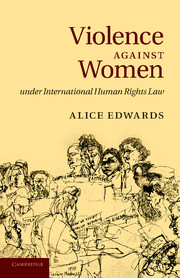Book contents
- Frontmatter
- Contents
- Preface
- Acknowledgements
- Table of cases and advisory opinions
- Table of treaties and other international instruments
- Abbreviations and acronyms
- 1 Introduction
- 2 Feminist theories on international law and human rights
- 3 The international human rights treaty system: practice and procedure
- 4 Equality and non-discrimination on the basis of sex
- 5 Torture and other cruel, inhuman, or degrading treatment or punishment
- 6 The right to life
- 7 Conundrums, paradoxes, and continuing inequality: revisiting feminist narratives
- 8 Strategising next steps: treaty body reform and towards humanising women
- Bibliography
- Index
4 - Equality and non-discrimination on the basis of sex
Published online by Cambridge University Press: 05 July 2011
- Frontmatter
- Contents
- Preface
- Acknowledgements
- Table of cases and advisory opinions
- Table of treaties and other international instruments
- Abbreviations and acronyms
- 1 Introduction
- 2 Feminist theories on international law and human rights
- 3 The international human rights treaty system: practice and procedure
- 4 Equality and non-discrimination on the basis of sex
- 5 Torture and other cruel, inhuman, or degrading treatment or punishment
- 6 The right to life
- 7 Conundrums, paradoxes, and continuing inequality: revisiting feminist narratives
- 8 Strategising next steps: treaty body reform and towards humanising women
- Bibliography
- Index
Summary
Introduction
This chapter explores how the international human rights treaty bodies, and other international institutions, have responded to violence against women via the principles of equality between men and women and non-discrimination on the basis of sex. In the absence of an explicit prohibition on violence against women within any international instrument at the time, the Women's Committee in 1989, and again in 1992, declared that violence against women is a form of sex discrimination (VAW=SD). Other treaty bodies and international human rights courts and tribunals also adopt similar approaches. In this chapter I am particularly interested in how sex discrimination and inequality are understood under international law; what these understandings mean for the inclusion of women and their lives within these prohibitions; and whether the ‘gender mainstreaming’ strategy of incorporating violence against women as a form of sex discrimination has produced any real results for women, or whether it has in fact bolstered the myriad feminist critiques of the international system outlined in Chapter 2.
This chapter is divided into two main parts. The first part analyses how these principles have been understood generally under international law, followed by their application to cover violence against women in particular. I explore five issues relating to equality/non-discrimination: formal versus substantive equality; discrimination versus equality; public and private discrimination; structural inequality; and multiple discrimination. Within this exploration, relevant feminist critiques are highlighted, as well as three feminist proposals for reconceptualising how we understand equality under international law.
- Type
- Chapter
- Information
- Violence against Women under International Human Rights Law , pp. 140 - 197Publisher: Cambridge University PressPrint publication year: 2010



